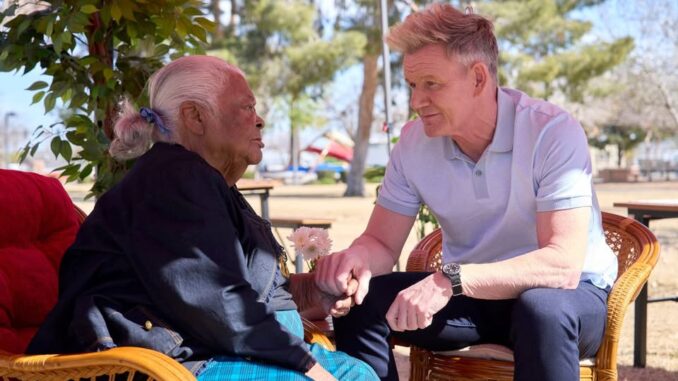
In the heart of Phoenix, Arizona, tucked into a neighborhood rich with history and resilience, stood a restaurant that was once more than just a place to eat—it was a community landmark. Mrs. White’s Golden Rule Café had served generations with its comforting soul food, built on a foundation of family recipes, southern hospitality, and a golden rule of kindness. But in a shocking twist, the once-beloved institution was in deep trouble—financially strained, emotionally drained, and dangerously close to becoming a ghost of its former self.
Enter Gordon Ramsay.
The celebrity chef, known for his fiery temper and unapologetic honesty, arrived not just with criticism, but with purpose. As part of his “Kitchen Nightmares”-style series Gordon Ramsay’s Food Stars: Secret Service, Ramsay selected Mrs. White’s Golden Rule Café for a mission not many saw coming. What unfolded was a raw, emotional episode that revealed just how fragile legacy can be—and how much fight it takes to save it.
A Legacy at Risk
Mrs. White’s Golden Rule Café was more than just a restaurant. Opened in 1964 by the legendary Elizabeth White, it was a cornerstone of Phoenix’s Black community. Known for its fried chicken, oxtails, cornbread, and peach cobbler, the café had once drawn celebrities, politicians, and locals alike. But times had changed. The pandemic, rising costs, and generational friction had eroded the café’s reputation and consistency.
When Ramsay walked in, he didn’t find the bustling warmth he expected. He found silence, faded decor, a disorganized kitchen, and—perhaps most heartbreakingly—a staff that had lost its spark. What was once a Phoenix gem was now a shell of its former self.
Tough Love, Ramsay-Style
Gordon Ramsay doesn’t mince words. And from the moment he tasted the food and inspected the kitchen, he let the owners know exactly how far the café had fallen. He criticized everything from underseasoned dishes to neglected equipment. But it wasn’t cruelty—it was clarity. Ramsay saw potential buried beneath years of complacency and mismanagement.
The most emotionally charged moments came when Ramsay sat down with Larry “Lo-Lo” White, Mrs. White’s grandson, who had taken over the family legacy. Ramsay challenged him on leadership, communication, and whether he truly wanted to carry the torch. It wasn’t just about food; it was about identity, ownership, and pride. The tension was real—but so was the possibility of redemption.
Rebuilding From the Inside Out
What made this episode of Secret Service different was that it wasn’t just about renovating a menu or revamping décor. Ramsay took a holistic approach. He brought in new kitchen systems, retrained the staff, and revamped the menu to honor the café’s roots while modernizing the experience. Gone were the microwaves and shortcuts; in came freshly prepared ingredients and reimagined soul-food classics.
He also revitalized the dining area, balancing tradition with freshness. Historical photos and memorabilia paid homage to Mrs. White’s legacy, while the refreshed space invited a new generation to fall in love with the restaurant all over again.
And it worked—at least for a time.
The Emotional Core: Family and Food
At the heart of this episode was a deeper story about generational legacy. Mrs. White’s presence loomed large—not as a haunting shadow, but as an inspiration. Ramsay’s visit forced the White family to confront not just business issues, but emotional ones. Was the café still a source of joy? Or had it become a burden too heavy to bear?
The candid conversations between Lo-Lo and his team, especially his mother and loyal staff, struck a chord with viewers. Many saw reflections of their own family dynamics, especially in the difficult dance of honoring tradition while adapting to change.
Food, after all, is never just food. It’s memory, identity, connection—and Ramsay understood that better than anyone.
After the Cameras Left
As with many Ramsay rescues, the aftermath is often where the real story unfolds. Mrs. White’s Golden Rule Café enjoyed a temporary boost in publicity and foot traffic following the episode. Social media buzzed with praise and support. Locals returned, many for the first time in years, drawn by curiosity and loyalty.
But sustainability is always the challenge.
Running a restaurant is grueling work, and legacy doesn’t pay bills. It’s unclear whether the changes Ramsay implemented endured long-term. Some reports suggest the café faced continued struggles, while others say the episode rekindled hope and accountability.
What is certain, however, is that Secret Service gave the café a second chance—and gave its story a national stage.
A Larger Message
The story of Mrs. White’s Golden Rule Café is more than a single episode—it’s a case study in what it means to fight for something bigger than yourself. It’s about the power of community spaces, the fragility of heritage businesses, and the complexity of family-run operations.
Ramsay, often criticized for his harsh tone, showed in this episode that beneath the yelling is a deep respect for passion, legacy, and grit. His mission wasn’t just to fix food; it was to light a fire. Whether or not the café remains successful, Ramsay’s intervention forced vital conversations about pride, adaptation, and resilience.
Conclusion: A Golden Rule to Live By
At the end of the episode, Ramsay stood in the revamped café and offered words rarely heard from him: admiration and hope. Mrs. White’s Golden Rule—treat others how you want to be treated—was more than a name. It was a philosophy. And through his tough love and genuine investment, Gordon Ramsay reminded us that sometimes, the best way to honor the past is to fight like hell for the future.
